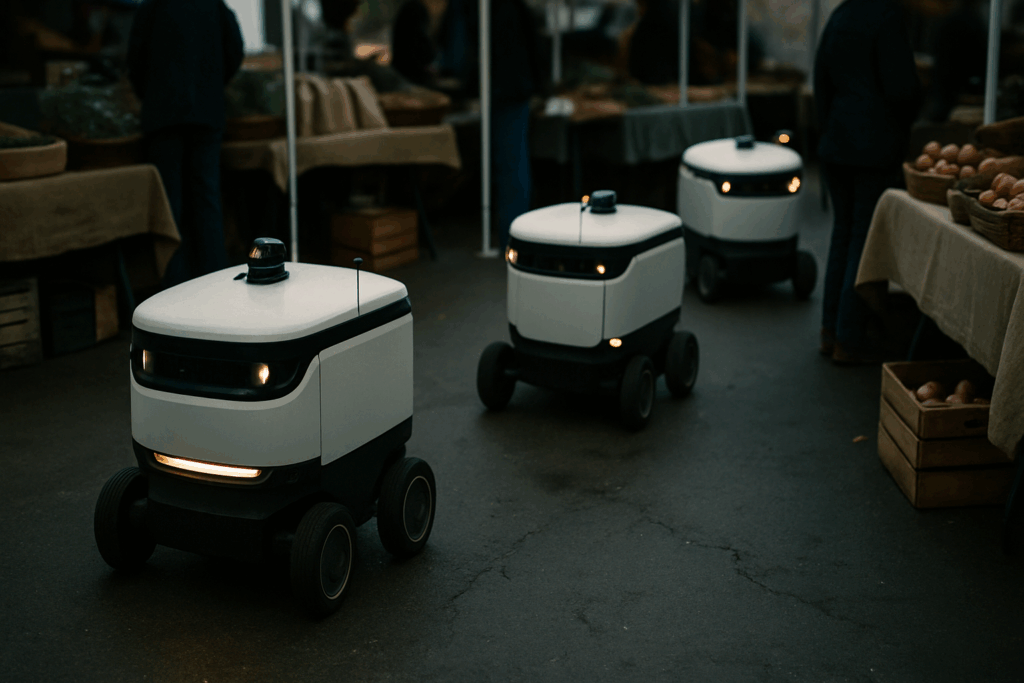Smarter Warehousing with AMRs
Autonomous Mobile Robots (AMRs) are transforming warehouse operations by tackling some of the most persistent challenges: travel time, efficiency, accuracy, and layout flexibility.
Reducing Worker Travel Time
Manual movement across large warehouse facilities eats into valuable time and labor. AMRs help cut down on excessive walking and manual transport by taking over the repetitive material handling tasks.
- AMRs automatically move materials from storage to picking zones
- Workers spend more time on high-value activities
- Travel distances and fatigue are significantly reduced
Boosting Throughput with Round-the-Clock Productivity
Unlike human workers, AMRs don’t need breaks or shift rotations. This enables warehouses to maintain constant operational flow without downtime.
- Operate 24/7 without compromising efficiency
- Handle repetitive routes at consistent speeds
- Improve output during peak hours and off-hours
Minimizing Errors in Picking and Sorting
Accuracy is critical in modern fulfillment centers. AMRs reduce the chance of human error by using sensors and programmed logic to follow optimized paths and sorting protocols.
- Help ensure the right items reach the correct station
- Reduce mispicks and the cost of order correction
- Integrate easily with Warehouse Management Systems (WMS) for real-time updates
Handling Dynamic Floor Plans and Adaptive Workflows
AMRs are designed to work in fluid environments. They are easily reprogrammed or trained to adjust to new layouts, work zones, or priorities without major disruption.
- Use real-time mapping and navigation to move safely
- Adjust to layout changes with minimal manual input
- Scale quickly to support changing inventory or order volume
Smarter material handling with AMRs allows warehouses to operate with more speed, precision, and adaptability—helping teams remain competitive in a fast-moving logistics landscape.
The Logistics Pressure: Faster Fulfillment, Tighter Margins
The pressure on logistics has never been higher. Consumers expect next-day delivery or faster, but supply chains are stretched thin and costs keep rising. Retailers and warehouses are chasing tighter fulfillment windows while fighting to stay profitable. Every margin point counts now.
Traditional warehouse automation—conveyor belts, AS/RS, and fixed robotics—can’t keep up with this pace. They’re rigid, expensive to scale, and not built to adapt in real time.
This is where Autonomous Mobile Robots, or AMRs, come in. Unlike the old systems, AMRs are smart, mobile units that can navigate warehouse floors and adapt to shifting workflows. They don’t need tracks. They avoid human workers. And they can be deployed fast. For modern operations, they’re no longer a futuristic add-on. They’re the new baseline for staying competitive.
Autonomous mobile robots (AMRs) are changing the face of modern logistics, and the reasons are clear. They move freely through space, thanks to smart sensors, advanced AI, and real-time navigation tech. No need for magnetic strips or fixed routes. Just machines that adapt to the environment in the moment.
Where traditional automation like conveyors or automated guided vehicles (AGVs) require fixed infrastructures, AMRs offer flexibility. They can reroute, dodge obstacles, and scale up or down based on demand. This kind of agility wasn’t possible before—and it’s why companies looking to stay lean are jumping on board fast.
The other edge? Most AMRs can be rolled out without gutting existing systems. Whether it’s a retrofit or a quick start in a new facility, deployment timelines are short, and capital costs are manageable. For operations under pressure to move faster with less, AMRs are the obvious play.
Micro-Niching for Loyal, High-Intent Audiences
Vlogs aren’t just about reach anymore. In 2024, it’s about resonance. The creators seeing real traction aren’t chasing the biggest possible audience. They’re going deep with specific, often overlooked communities. Think “vanlife for single dads” or “sustainable streetwear hauls.” These hyper-specific angles might sound limiting, but they build stronger loyalty and real connection.
Micro-niching trims the fat. You don’t need a million subscribers when a dedicated five thousand are watching every post, commenting, sharing, and buying. These audiences are high-intent—they’re not just scrolling aimlessly. They’re there for something specific, and when a vlogger delivers it consistently, the return shows up on every metric: watch time, engagement, and revenue.
It also stretches monetization options. Niche followers convert better for sponsors. They support merch. They join memberships. As algorithm pressure grows and competition ramps up, going smaller might just be the smartest way to play big.
Robots aren’t here to replace vloggers or their teams. They’re here to support the grind. AI tools and smart software are taking over some of the tedious parts—think editing timelines, audio syncing, captioning—but the human role isn’t shrinking. It’s shifting.
Instead of burning out doing manual cuts and uploads, creators are learning how to manage AI tools. That means training in automation platforms, learning prompt-based scripting, and understanding how to fine-tune AI outputs to match their tone. This move from doing everything by hand to supervising intelligent software is the new skill curve.
The result? Less stress, fewer midnight edits, and more time for the parts only a human can deliver—like creativity and connection. In short, it’s not about replacement. It’s about making the job smarter, safer, and a lot more sustainable.
Autonomous Mobile Robots (AMRs) aren’t operating in isolation anymore. In today’s smarter warehouses and production environments, they’re tightly integrated with Warehouse Management Systems (WMS), Enterprise Resource Planning (ERP) software, and IoT sensors. This networked setup gives AMRs real-time access to inventory levels, order data, and environmental cues like temperature or obstacle changes. The result? Faster decisions, fewer errors, and minimal downtime.
But it’s fleet management software that’s turning this from automation into orchestration. With it, businesses can monitor an entire AMR fleet, adjust routes on the fly, and manage maintenance schedules without human micromanagement. The software acts like mission control, making sure each robot is in the right place, doing the right job at the right time.
While all this sounds futuristic, the distinction between robotic process automation (RPA) and older, more rigid automation setups is worth understanding. For a deeper breakdown, see Robotic Process Automation vs Traditional Automation.
Warehousing Is Being Reimagined, Not Replaced
Modern warehousing isn’t going away—it’s transforming into something faster, smarter, and far more flexible. Instead of dismantling the traditional concept of a warehouse, technology is reshaping it to better suit today’s supply chain demands.
From Static Storage to Smart Systems
Warehouses are evolving from static storage hubs into dynamic, data-driven operations. Companies are prioritizing adaptability and intelligence, with automation playing a central role.
Key shifts include:
- Smarter layouts that adjust to real-time workflows
- AI-powered inventory tracking and demand forecasting
- Scalable setups that reduce waste and boost responsiveness
The Role of AMRs in Agile Operations
Autonomous Mobile Robots (AMRs) are not just trendy tech—they are essential tools in the shift toward agile operations. These robots are designed to adapt in real time, making warehouses more flexible and resilient.
- AMRs handle repetitive tasks with high efficiency
- They integrate easily with existing systems and layouts
- Their real advantage lies in enabling fast pivots and process improvements
Adapt Today, Lead Tomorrow
Forward-thinking companies are investing in reimagined warehousing not just to survive supply chain disruptions, but to gain a competitive edge. Those that harness agile systems and intelligent tech will position themselves miles ahead of companies stuck in legacy models.
- Investing now creates operational resilience
- Innovation in warehousing directly improves customer experience
- Staying ahead of the curve means faster fulfillment, better insights, and long-term growth
Smarter Mobility: How AMRs Are Evolving Fast
Autonomous mobile robots (AMRs) aren’t just warehouse workhorses anymore. Thanks to advances in AI and machine learning, their navigation is becoming sharper, more adaptive, and better at making decisions in real time. Instead of rigidly following pre-mapped routes, newer models are reacting to shifting human and machine traffic alike, learning environments on the fly, and avoiding surprises before they turn into slowdowns.
Interoperability is also moving from buzzword to baseline. More AMR manufacturers and platforms are aligning with open standards, making it easier for diverse fleets to talk to each other and mesh with legacy systems. This cuts down on one-off integrations and gives businesses more flexibility when scaling up or mixing models.
And the most surprising shift? AMRs are moving beyond warehouses. Expect to see them managing tasks in hospitals, patrolling campuses, delivering goods in retail, and feeding just-in-time parts to car assembly lines. Robots once glued to sterile supply chain corridors are now cutting across sectors, bringing their transport skills wherever repetitive movement is costing time and money.
The age of smarter, sector-hopping AMRs is underway. It hits faster than most realize—and it’s here to stay.


 Mikeric Edwardsons is a technology writer at gfxrobotection, specializing in cybersecurity trends, software solutions, and modern tech innovations. His content simplifies complex topics to deliver real value for both beginners and tech professionals.
Mikeric Edwardsons is a technology writer at gfxrobotection, specializing in cybersecurity trends, software solutions, and modern tech innovations. His content simplifies complex topics to deliver real value for both beginners and tech professionals.

